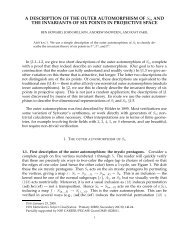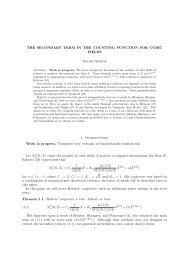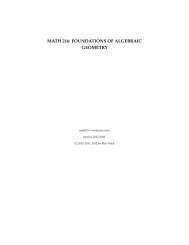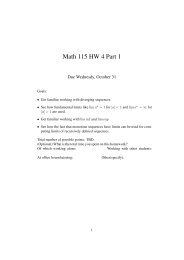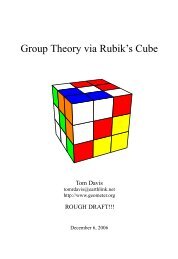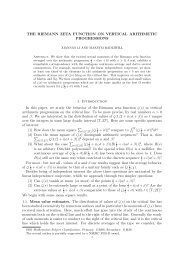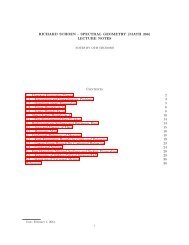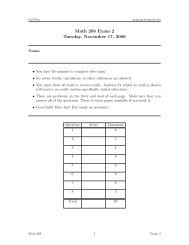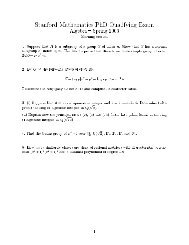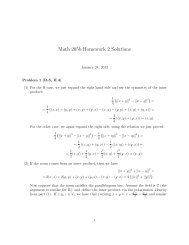Traveling Wave Solutions in a Reaction-Diffusion Model for Criminal ...
Traveling Wave Solutions in a Reaction-Diffusion Model for Criminal ...
Traveling Wave Solutions in a Reaction-Diffusion Model for Criminal ...
You also want an ePaper? Increase the reach of your titles
YUMPU automatically turns print PDFs into web optimized ePapers that Google loves.
start<strong>in</strong>g po<strong>in</strong>t is the system <strong>in</strong>troduced <strong>in</strong> [3]:<br />
st(x, t) = ∆s(x, t) − s(x, t) + sb(x) + (ρ(x) − c(x, t))u(x, t) (1a)<br />
ut(x, t) = 1<br />
(Λ(s) − u(x, t))<br />
τu<br />
ct(x, t) =<br />
(1b)<br />
1<br />
<br />
<br />
u(x, t)p(x)<br />
−c(x, t) + c0 + ηcc0 − 1 ,<br />
u(x, t)p(x)<br />
(1c)<br />
τc<br />
def<strong>in</strong>ed <strong>for</strong> x ∈ R n and t ≥ 0. The unknowns are: the mov<strong>in</strong>g average of crime, u(x, t),<br />
the population’s propensity to commit a crime, s(x, t), and the cost of committ<strong>in</strong>g a crime,<br />
c(x, t). This model, as the model studied <strong>in</strong> [19], is based on two fundamental assumptions from<br />
crim<strong>in</strong>ology theory: rout<strong>in</strong>e activity theory [6] and the repeat and near-repeat victimization effect.<br />
Rout<strong>in</strong>e activity theory states that the two essential elements <strong>for</strong> a crime to occur are a motivated<br />
agent and an opportunity, and neglects the other factors. This has the additional benefit of<br />
mak<strong>in</strong>g the problem mathematically tractable. The repeat and near-repeat victimization effect,<br />
which has been observed <strong>in</strong> real crime data, is the effect that crime <strong>in</strong> an area leads to more<br />
crime [12, 21].<br />
We now briefly expla<strong>in</strong> how (1) <strong>in</strong>corporates the above assumptions, see [3] <strong>for</strong> more details.<br />
Let us start with (1b). The most fundamental assumption is that the mov<strong>in</strong>g average of crime<br />
u(x, t) and the propensity to commit crime s(x, t) positively <strong>in</strong>fluence each other. If s(x, t) is<br />
non-positive then it does not affect the crime average but if s(x, t) becomes positive, its <strong>in</strong>fluence<br />
on the crim<strong>in</strong>al activity <strong>in</strong>creases. The fraction of the population at a given place and time that<br />
will commit a crime is given by<br />
Λ(s) =<br />
0 s < 0<br />
1 − e −βs s ≥ 0.<br />
Here β > 0 is a given constant. When s(x, t) = 0 the crime will disappear on the time scale τu,<br />
and the balance of these two effects gives (1b).<br />
The propensity to commit a crime, s(x, t), evolves proportionally to the amount of crime: it<br />
is observed <strong>in</strong> the crime data that crime leads to more crime, this is the ‘repeat and near-repeat<br />
victimization effect’. Hence, we assume that s(x, t) <strong>in</strong>creases proportionally to u(x, t) with a<br />
rate that is the difference of two effects: ρ(x) measures the payoff of committ<strong>in</strong>g a crime and<br />
c(x, t) is its cost. Note that ρ(x) is naturally spatially heterogeneous as different neighborhoods<br />
have different payoff <strong>for</strong> a successful crime. A good example to keep <strong>in</strong> m<strong>in</strong>d is residential<br />
burglaries, where the net payoff of a successful burglary is higher <strong>in</strong> wealthier neighborhoods.<br />
In addition, the diffusion term <strong>in</strong> (1a) takes <strong>in</strong>to account the non-local effect that can also<br />
be seen on the example of residential burglaries. The constant sb <strong>in</strong> (1a) is the equilibrium<br />
value, or a measure of the population <strong>in</strong>nate tendency towards crim<strong>in</strong>al activity. If sb < 0<br />
the population is assumed to have a natural anti-crime tendency, sb = 0 assumes a natural<br />
<strong>in</strong>difference towards crim<strong>in</strong>al activity, and sb > 0 assumes an natural tendency towards crim<strong>in</strong>al<br />
activity. The function sb(x) corresponds to the base attractiveness value Ao(x) <strong>in</strong> the model<br />
<strong>in</strong>troduced <strong>in</strong> [19]. To the authors’ knowledge there have been no studies of the important effect<br />
that the base attractiveness value has on the long time behavior of the solutions. Here we show<br />
that sb plays a significant role <strong>in</strong> the long term behavior of crim<strong>in</strong>al activity patterns.<br />
Equation (1c) models what is referred to <strong>in</strong> [3] as an adaptive cost, assum<strong>in</strong>g that resources<br />
are allocated at high crime rate areas. This is known as hotspot polic<strong>in</strong>g. As a first step, we<br />
study a model that does not consider the dynamics of the cost (8)<br />
st(x, t) = ∆s(x, t) − s(x, t) + sb + α(x)u(x, t) (3a)<br />
ut(x, t) = Λ(s) − u(x, t). (3b)<br />
Furthermore, we assume that sb is spatially homogeneous (sb(x) ≡ sb). We plan to address the<br />
full model <strong>in</strong> the near future.<br />
2<br />
(2)



